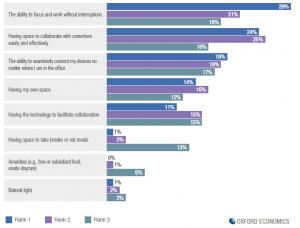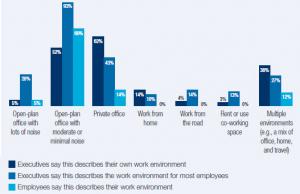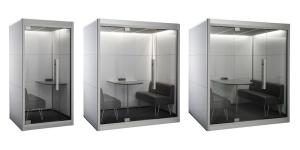8 Ways to Reduce Noise in Your Workplace
Does unwanted noise interfere with getting your work done? Read more about the 8 tips to help reduce workplace noise so you can work more efficiently.
AUSTIN, TEXAS, UNITED STATES, October 23, 2018 /EINPresswire.com/ -- Many employees find that a lively, open-office workplace brimming with the sounds of enthusiastic colleagues working together makes for a positive, invigorating place to collaborate on work projects. Yet others strenuously disagree; they find that unwanted office noise interferes with their ability to get productive work done. What to do? We offer eight practical tips on how to establish an office noise reduction program at your workplace that will help make your employees happier and more productive.For many, today’s dream office has the look-and-feel of a converted warehouse loft — with an industrial look that features natural brick walls, expanses of poured concrete, open fixture lighting systems, as well as exposed pipes and ductwork. Indeed, this office look, which originated with media and tech companies, has become an established trend, as we’ve written about quite a few times. This style of workplace conveys a confident, modern (if not retro) design language that’s especially attractive to Millennials who have unique ideas about how work environments should look (hint: like a hipster coffeehouse). Managers and space planners also like the overall efficiency that these spaces provide: they hold out the promise of flexibility and collaboration-driven innovation. But there can be significant downsides if you are not careful: unless there is proper planning for acoustic comfort, these open office designs, with their hard, noise reflecting surfaces, can wreak havoc on employee satisfaction among those who find extraneous noise to be a productivity deal-breaker.
The issue of unwanted office noise hasn’t gone down quietly. More and more office acoustic “fails” are making the news.
For example, a year after the 935 million-dollar Francis Crick Institute opened in King’s Cross, London, it’s been widely reported that many of the institute’s 1,200 plus scientific researchers and office staff complain that the workplace is simply too noisy for them to concentrate effectively on their research and writing tasks.
Some of the programming developers at Apple have also recently expressed their dissatisfaction with a recent transition into open office spaces at Apple Park — a move that many employees feel favors a push toward noisy collaboration that comes at the expense of intense, quiet concentration.
Whether the unwanted noise situation is brought about by overhearing loud co-worker telephone calls, overly enthusiastic clickety-clack keyboarding, the incessant sounds of office equipment (especially large printers and copiers), or simply the repeated noise of doors opening and closing, it’s having an effect on many of today’s employees.
Research indicates that the most distracting type of noises in the workplace are the unwanted/unrelated conversations that you can’t help but overhear. The mind can’t help but want to tune in and make sense of conversations we can hear, even if it’s as banal as hearing about re-scheduling a babysitter for your colleague’s 10th-anniversary dinner on the evening of the second Tuesday of next month…
So it’s not surprising that a recent Oxford Economics Study found that, given a choice of perks, employees’ first choice was a quiet office environment where they could focus on work. This ranked higher than any other benefit — including some fairly expensive ones, such as free meals at the office or onsite daycare.
The bottom line? Managers need to get on top of this issue by implementing noisy office solutions before they face long-term issues, such as poor worker productivity, lower job satisfaction, and decreased retention rates.
HOW TO KEEP THE WORKPLACE NOISE LEVELS IN CHECK
Let’s look at eight practical ways you can make positive strides in office noise reduction.
1. OFFICE NOISE REDUCTION STARTS WITH CAREFUL SITE SELECTION AND CONSTRUCTION DETAILS
It may be obvious, but a compromised site selection, such as one located near a busy freeway, airport, or industrial facility does not work in your favor. If noisy neighbors can’t be avoided, innovations such as modern window glazing solutions can control how much outside noise enters the building. If you are looking at leasing new office space, you’ll also want to investigate the building’s mechanical systems (such as elevators and HVAC systems) for acoustic pathways, which could introduce unwanted noise into your office space.
If you are building a new facility from scratch, you can start your office noise control program during the design and planning phase. For example, to isolate the sound of conversations between different rooms or floors, acoustic design experts can specify construction materials with enough ‘mass’ to absorb this type of noise. Low vibration noises, such as those emanating from nearby construction sites or street traffic, can be addressed by damping techniques that attenuate sound vibrations; this can be accomplished by using custom materials or applying special glue-like dampening compounds between stiff surfaces, such as drywall or plywood, to make a noise absorbing ‘sandwich.’ Because sound vibrations can travel long distances through the structure of a building, acoustic experts can also specify de-coupling ‘gaps’ in the structure that prevent sound vibrations from moving from one part of the building to another. Finally, absorption materials can be introduced in the interior, such as acoustical ceiling tiles, baffles, carpets, and engineered floors, which we’ll talk about in detail below.
2. ESTABLISHING DEDICATED LOUD AND QUIET ZONES CAN HELP WITH OFFICE NOISE CONTROL
Creating a floor plan that supports inter-space noise control is also very important. Keep areas with noisy office equipment, such as large printers and copiers, away in isolated areas. (This can also help control unwanted indoor ozone pollution produced by these devices as well.) Other high noise areas, such as kitchen messes, cafeterias, and break rooms, also need to be acoustically isolated from work areas. Conference rooms are another obvious example of spaces that are inherently noisy. Restrooms also fall into this category, as do impromptu meeting areas and lobbies.
But what about creating other specific task zones for noisy activities within the core work areas of your office? If you dig a little deeper, there are other opportunities to create specific zones where noise generating activities take place without distracting other workers — for example, why not create convenient “telephone booths” that staff can duck into when they need to make a distracting phone call? (You may recall we highlighted some freestanding “phone booth” designs spotted earlier this year at NeoCon 2017.)
Now, let’s discuss the reverse: the need to build quiet spaces for those workers who need to concentrate with maximum attention, e.g. those working “in the zone.” Susan Cain, author of Quiet: The Power of Introverts in a World That Can’t Stop Talking, promotes the idea that many of us “introverts” have to have quiet spaces to work in order to remain productive. Short of creating dedicated private offices for each of these employees (which may not be possible in your budget), one possible solution is to provide quiet hoteling spaces, which can be shared or “checked” in or out of like a hotel room.
Don’t overlook other simple solutions as well. Creating an office convention, such as signage at the entrance to a work area that indicates a request for extra quiet during a project crunch time can help maintain a productive work environment. (Some have even created a lighted sign system to do this.)
3. CUSTOMIZE YOUR FURNITURE TO CONTROL NOISE IN THE WORKPLACE
First a bit of unsettling research.
Workers in enclosed offices are the happiest. But that’s the least economical solution. What about the next best alternative, which presumably would be cubicle furniture systems with high partitions? Aren’t these looked upon more favorably than full, open desking and benching solutions?
Read more ... https://formaspace.com/articles/office-furniture/8-ways-to-reduce-noise-in-the-workplace/?utm_source=einpresswire&utm_medium=content&utm_campaign=article-102318
Brooke Turner
Formaspace
8002511505
email us here
Legal Disclaimer:
EIN Presswire provides this news content "as is" without warranty of any kind. We do not accept any responsibility or liability for the accuracy, content, images, videos, licenses, completeness, legality, or reliability of the information contained in this article. If you have any complaints or copyright issues related to this article, kindly contact the author above.




